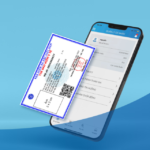With the continuous advancement of technology, the chip-embedded Citizen Identity Card will become a future replacement for personal identification papers. FPT Shop will provide you with detailed information and answer any questions you may have about the chip-embedded Citizen Identity Card.
Definition of the chip-embedded Citizen Identity Card
The chip-embedded Citizen Identity Card is an electronic card that replaces the ID card and Citizen Identity Card, with an integrated chip and processor to store personal information. This card helps citizens easily identify and authenticate their identity, as well as perform administrative procedures conveniently and effectively.
/fptshop.com.vn/uploads/images/tin-tuc/134625/Originals/can-cuoc-cong-dan-gan-chip-1.jpg)
Cases where it is mandatory to replace the chip-embedded Citizen Identity Card
- People born in the years 1998, 1983, and 1963, when they reach the ages of 25, 40, and 60 respectively (in 2023).
- People whose ID card or Citizen Identity Card has expired after 15 years.
- Damaged or unusable ID card or Citizen Identity Card.
- Changes in personal information such as last name, first name, identifying characteristics, gender, and hometown.
- Incorrect information on the Citizen Identity Card.
- Lost Citizen Identity Card.
- Acquiring Vietnamese citizenship.
/fptshop.com.vn/uploads/images/tin-tuc/134625/Originals/can-cuoc-cong-dan-gan-chip-2.jpg)
Documents required before applying for the chip-embedded Citizen Identity Card
- For initial registration or if personal information is not in the national population database or needs to be changed or updated: Bring the household registration book, temporary residence book, birth certificate, or other legal documents proving the changes or additional personal information.
- For converting from the ID card to the chip-embedded Citizen Identity Card: Bring the previous ID card and household registration book, or birth certificate, or other legal documents.
- For converting from the barcode Citizen Identity Card to the chip-embedded Citizen Identity Card: Bring the previous barcode Citizen Identity Card, or birth certificate, or other legal documents.
/fptshop.com.vn/uploads/images/tin-tuc/134625/Originals/can-cuoc-cong-dan-gan-chip-3.jpg)
Validity period of the chip-embedded Citizen Identity Card
The chip-embedded Citizen Identity Card (CCCD) has a validity period and needs to be replaced according to the regulations of the Citizen Identity Card Law 2014, Law No. 59/2014/QH13. According to the regulations, the CCCD must be replaced when citizens reach the ages of 25, 40, and 60. However, if the CCCD is issued, replaced, or re-issued within 2 years before reaching these ages, the card remains valid until the next age change.
However, there are cases where the CCCD has unlimited validity. For example, when a citizen reaches the age of 60, the CCCD remains valid for life without the need to change the card, unless the card is lost or damaged. Individuals who apply for the chip-embedded CCCD at the age of 58 can use the card until they pass away without having to change the card at the age of 60.
/fptshop.com.vn/uploads/images/tin-tuc/134625/Originals/can-cuoc-cong-dan-gan-chip-4.jpg)
Where to get the chip-embedded Citizen Identity Card
- Ministry of Public Security, the unit responsible for national management of the Citizen Identity Card.
- Provincial and municipal police, responsible for local management of the Citizen Identity Card.
- District and town police, administrative units under the province, and equivalent administrative units responsible for lower-level management of the Citizen Identity Card.
- Other authorities authorized to carry out card issuance procedures at the commune, ward, town, office, unit, or at the citizen’s place of residence upon request.
/fptshop.com.vn/uploads/images/tin-tuc/134625/Originals/can-cuoc-cong-dan-gan-chip-5.jpg)
Can the chip-embedded Citizen Identity Card be processed online?
According to Article 4 of Circular 60/2021/TT-BCA, citizens can register for the chip-embedded Citizen Identity Card in advance through the National Public Service Portal or the Ministry of Public Security’s Public Service Portal. However, after online registration, individuals still need to go to the police station in person to provide information, have their portrait taken, fingerprinted, and pay the fee. This means that individuals cannot currently apply for the chip-embedded Citizen Identity Card online at home, but can only preregister for the application process.
/fptshop.com.vn/uploads/images/tin-tuc/134625/Originals/can-cuoc-cong-dan-gan-chip-6.jpg)
When will you get your chip-embedded Citizen Identity Card?
According to the regulations in Organization 60/2021/TT-BCA, the processing time for applications and the issuance of Citizen Identity Cards have the following provisions:
For applications received at the district police or administrative management unit for social order and safety, the processing time is 2 working days. After that, the electronic data is sent to the national population data center.
For applications received at the Administrative Management Police Department:
- The receiving unit will complete the processing, approval, and printing of the Citizen Identity Card within 3 working days after receiving all the electronic data.
- The national population data center will complete the processing, approval, and printing of the Citizen Identity Card within 4 working days after receiving the complete application.
After the complete printing, the Citizen Identity Card will be delivered to the designated place for card issuance, replacement, or re-issuance.
/fptshop.com.vn/uploads/images/tin-tuc/134625/Originals/can-cuoc-cong-dan-gan-chip-7.jpg)
How to check if your card is ready?
Method 1: Contact the police station where you submitted your application to inquire about the progress.
You can contact them by phone or through their Facebook page to get information about your application for the Citizen Identity Card.
Method 2: Call the hotline for instructions on the Citizen Identity Card of the Ministry of Public Security.
Use the hotline: 1900.0368 and press 4 to listen to information about the status of the Citizen Identity Card. This is the fastest way to get information about the card’s progress.
Method 3: Check on the National Public Service Portal.
Visit the website http://dichvucong.gov.vn/p/home/dvc-trang-chu.html, choose the service information section, then go to the application inquiry. Enter the application number for the Citizen Identity Card and the authentication code (printed on the appointment paper and below the barcode).
/fptshop.com.vn/uploads/images/tin-tuc/134625/Originals/can-cuoc-cong-dan-gan-chip-8_jpg.jpg)
Procedures for changing incorrect information on the chip-embedded Citizen Identity Card
Step 1: Go to the relevant police station and request to change the incorrect CCCD.
Step 2: Provide personal information to the police officer, including searching in the national population database, selecting the type of issuance, describing the identification characteristics, collecting fingerprints, and taking a portrait photo. The individual will also sign the collection and update information forms.
Step 3: The police officer will collect the old CCCD with incorrect information.
Step 4: Proceed with the search of the Citizen Identity Card archive to verify the information and process the application to change or re-issue the CCCD.
Step 5: The police station will return the result of the changed CCCD. If the individual has requested to return the CCCD to their address, the police station will make a list and coordinate with the delivery unit. The individual will have to pay the prescribed fee.
/fptshop.com.vn/uploads/images/tin-tuc/134625/Originals/can-cuoc-cong-dan-gan-chip-9.jpg)
Preparation tips to expedite the process of applying for the Citizen Identity Card
- Bring all the necessary documents such as household registration book, ID card, and birth certificate (if necessary). This will facilitate the verification of information and streamline the identification process.
- When visiting the Citizen Identity Card office, maintain order and follow the instructions of the police officers. This helps maintain order and avoid confusion and demonstrates respect for their work.
- When applying for the CCCD, dress appropriately and keep your hair neat for a good ID photo. Although there are no strict regulations on makeup or hairstyles, avoid heavy makeup or drastic changes in appearance to ensure the card photo’s identification integrity.
- If fingerprints are unclear, moisturize your hands with a good quality moisturizer before fingerprinting. This helps clarify and expedite the fingerprint identification process.
- When taking the CCCD photo, adhere to regulations regarding hairstyle, eyes, and attire. Expose both ears clearly, do not wear glasses in the photo (if possible), and choose attire that is serious and presentable.
/fptshop.com.vn/uploads/images/tin-tuc/134625/Originals/can-cuoc-cong-dan-gan-chip-10.jpg)
How to report if you have not received the chip-embedded Citizen Identity Card
Method 1: Use the feedback channels of the National Population Data Center. You can send your feedback through the Facebook page of the National Population Data Center.
Method 2: Send an email reporting the non-receipt of the chip-embedded Citizen Identity Card. You can send your feedback to the email address: [email protected] for the Administrative Management Police Department to process and respond to your issue.
Method 3: Contact the Ministry of Public Security’s hotline for assistance. Call 1900.0368 and press the number 4 for advice and answers to your questions regarding the Citizen Identity Card. The hotline will connect you with a Ministry representative who can listen to your concerns and provide necessary support.
Method 4: Contact the local Citizen Identity Card issuing agency directly. You can contact the district administrative management police office (at the provincial level) or the administrative management police team (at the district level) at the place of your residence to inquire about the status of your card and receive guidance on necessary procedures.
/fptshop.com.vn/uploads/images/tin-tuc/134625/Originals/can-cuoc-cong-dan-gan-chip-11.jpg)
Recent amendments to the Citizen Identity Card Law (latest in 2023)
In 2023, the proposed amendments to the Citizen Identity Card Law include the following key points:
- Integrating information in the chip-embedded Citizen Identity Card to simplify procedures and improve the effectiveness of population management.
- Expanding the information stored in the national population database and the Citizen Identity Card database to enhance the ability to search and manage individuals’ personal information.
- Expanding the eligible individuals for obtaining the Citizen Identity Card and Citizen Identity Certificate to provide more convenient conditions for different individuals in society.
- Improving regulations on the management, operation, exploitation, and use of information in the national population database and the Citizen Identity Card database to ensure the safety and security of personal information.
It is worth noting that the proposal also suggests “phasing out” the ID card from January 1, 2025. However, ID cards with expiration dates issued before the effective date of the amended Citizen Identity Card Law will remain valid until December 31, 2024. Legal documents using information from ID cards will remain valid.
/fptshop.com.vn/uploads/images/tin-tuc/134625/Originals/can-cuoc-cong-dan-gan-chip-12.jpg)
Conclusion
Hopefully, with the information provided above, you have gained a better understanding of the chip-embedded Citizen Identity Card and obtained answers to common questions about the chip-embedded Citizen Identity Card. Leave a comment below to let FPT Shop know your thoughts!
Fastest and Most Accurate Child Personal Identification Number Lookup Guide
How can parents look up the personal identification number for their child when the child is not old enough to get a citizen identification card? This is a question that many parents are currently concerned about. Let’s find out how to look up the personal identification number for children in the article below.
Easy and Convenient Steps to Look up the Value of Your BHYT Card
Looking up the value of health insurance card (BHYT) is a way for participants to know and check the expiration date as well as other related information of their health insurance card. In this article, FPT Shop will guide you through some easy and completely free methods to look up the value of your BHYT card.
Simple Steps to Lookup 2024 Electronic Household Registration Book Online
Looking up an electronic household registration book is a way for individuals to know and check their residential information as well as the information of their family members. In this article, FPT Shop will guide you on how to easily look up an electronic household registration book, completely free of charge, through the Vietnam Social Insurance website.





































